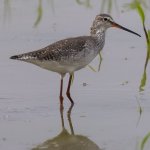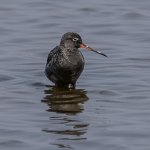Aladdin
Well-known member

Dear Members and Bird watchers!
Birding at eBird hotspot Pathum Thani Rice Research Center in Thailand. I passed the bird and I took a picture and instantly ID the bird as a Common Redshank and I did not give it any more thoughts. Until I got home to look at the pictures.
The bird on the attached picture have a red lower bill and the upper bill is black as a Spotted Redshank. The Common Redshank have both upper and lower bill red.
So my thought is that the bird is a Spotted Redshank moulting from winter to breeding plumage. In my book the bill look the same for winter and breeding plumage, both spotted and common.
Am I wrong in my changed ID?
Kind Regards and happy birding!
Aladdin
Birding at eBird hotspot Pathum Thani Rice Research Center in Thailand. I passed the bird and I took a picture and instantly ID the bird as a Common Redshank and I did not give it any more thoughts. Until I got home to look at the pictures.
The bird on the attached picture have a red lower bill and the upper bill is black as a Spotted Redshank. The Common Redshank have both upper and lower bill red.
So my thought is that the bird is a Spotted Redshank moulting from winter to breeding plumage. In my book the bill look the same for winter and breeding plumage, both spotted and common.
Am I wrong in my changed ID?
Kind Regards and happy birding!
Aladdin





